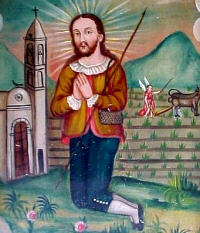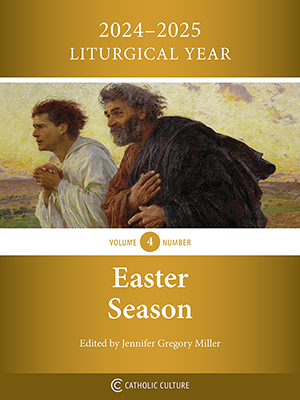Easter: May 15th
Thursday of the Fourth Week of Easter; Opt. Mem. of St. Isidore (USA)
» Enjoy our Liturgical Seasons series of e-books!
The United States celebrates the Optional Memorial of St. Isidore the Farmer (1070-1130). He was a Spanish laborer who worked most of his life as a ploughman for a nobleman who lived near Madrid, Spain. Although working many hours a day, he never failed to attend daily Mass, and spend time praying before the Holy Eucharist. He married a maid-servant, Maria de la Cabeza, who was also canonized a saint. They were always willing to help their neighbors and worked with the poor in the city slums. In 1947, he was proclaimed the Patron of the Catholic Rural Life Conference in the United States.
Meditation for Thursday of the Fourth Week of Easter:
Baptism, Birth to the Supernatural Life
The life of the Risen Christ is the model of ours, and Christ has merited for us the grace of living for God as He did, the grace of being associated with His risen life. True, it was not by His Resurrection that Christ actually merited this grace. All that He acquired for us was won by His sacrifice which was inaugurated at His Incarnation and consummated by His death upon the Cross.
But His merits remain to us after His glorious coming forth from the tomb. And it is from our baptism that we share in this grace of the Resurrection. St. Paul affirms this: "We are buried together with Him by baptism unto death; that as Christ is risen from the dead by the power of the Father, so we also may walk in newness of life."
The holy water into which we are plunged at baptism is, according to the Apostle, the figure of the sepulchre; upon coming forth from it, the soul is purified from all sin, from all stain, set free from all spiritual death, and clad with grace, the principle of divine life: in the same way as upon coming forth from the tomb, Christ freed Himself from all infirmity so as to live henceforth a perfect life.
—Dom Marmion, Christ in His Mysteries, p. 290
St. Isidore the Farmer
 When he was barely old enough to wield a hoe, Isidore entered the service of John de Vergas, a wealthy landowner from Madrid, and worked faithfully on his estate outside the city for the rest of his life. He married a young woman as simple and upright as himself who also became a saint-Maria de la Cabeza. They had one son, who died as a child.
When he was barely old enough to wield a hoe, Isidore entered the service of John de Vergas, a wealthy landowner from Madrid, and worked faithfully on his estate outside the city for the rest of his life. He married a young woman as simple and upright as himself who also became a saint-Maria de la Cabeza. They had one son, who died as a child.
Isidore had deep religious instincts. He rose early in the morning to go to church and spent many a holiday devoutly visiting the churches of Madrid and surrounding areas. All day long, as he walked behind the plow, he communed with God. His devotion, one might say, became a problem, for his fellow workers sometimes complained that he often showed up late because of lingering in church too long.
He was known for his love of the poor, and there are accounts of Isidore's supplying them miraculously with food. He had a great concern for the proper treatment of animals.
He died May 15, 1130, and was declared a saint in 1622 with Ignatius of Loyola, Francis Xavier, Teresa of Avila and Philip Neri. Together, the group is known in Spain as "the five saints."
Patronage: against the death of children; agricultural workers; day laborers; farm workers; farmers; field hands; for rain; husbandmen; laborers; livestock; Mexican peasants; ranchers; Spanish peasants; rural communities; Farmers; farm workers; ranchers; rural communities; National Catholic Rural Life Conference in the United States.
See CatholicSaints.info for a full listing of organizations and locations that claim St. Isidore as patron.
Symbols and Representation: White oxen; spade; hoe or rake; plough
Highlights and Things to Do:
- St. Isidore (and his wife Maria) are the patrons of the Catholic Rural Life Conference. Read this reflection on St. Isidore, their patron, some ideas to celebrate his feast and Novena to St. Isidore.
- Learn more about St. Isidore the Farmer:
- See Christian Iconography for some images of St. Isidore.
- The remains of St. Isidore Hand his wife Santa María de la Cabeza are located in Church of San Isidro in Madrid.
- Establishing or replenishing a a Mary garden would be an appropriate way to celebrate the combination of the feast of St. Isidore and the month of May, dedicated to Mary.
- Visit mgardens.org to learn more about Mary Gardens.
- There is also a lovely book on Mary gardens printed by St. Anthony Messenger Press called Mary's Flowers: Gardens, Legends and Meditations by Vincenzina Krymow.
- Visit Stokes Marys Gardens.
- Another book by Vincenzina Krymow is Healing Plants of the Bible which explains Biblical gardens and plants.
Two books we especially recommend: Cooking for Christ by Florence Berger (although we prefer the original 1949 edition; this is an edited version), and Rural Life Celebration Guide.






